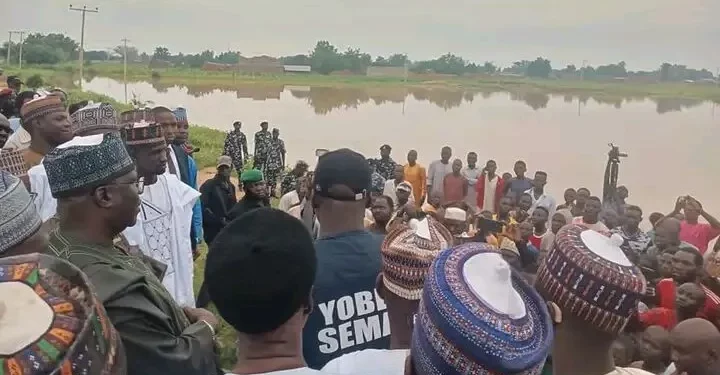Top federal and state government officials have assured host communities of major dams in the north of safety as fear grips them over the possible collapse of the facilities.
Since the Borno State flood tragedy, apprehension has enveloped the communities, who alleged that the dams were in poor state.
The perennial flooding in Goronyo and the surrounding local government areas of Sokoto State, no thanks to the Goronyo Dam, made the residents uncomfortable after the Borno disaster.
As the rumours of imminent collapse of Goronyo Dam became rife, the concerned people made a passionate appeal to the federal government to come to their rescue.
In its response, the federal government dismissed the rumours and called on residents of the community not to entertain any fear.
The assurance came from the minister for state for Water Resources, Barrister Bello Goronyo, an indigene of the area.
Goronyo described the story as the imagination of some mischievous people without any iota of truth whatsoever.
He said, “I was in Goronyo Dam recently, together with some of the officials of Sokoto-Rima River Basin, where we went to see things again. I am glad to say that the Dam is intact, good and with no problem whatsoever.
“The dam was designed to accommodate about 942 million cubic meters of water and the water level there is just about 685 million cubic meters of water.
“The dam can still accommodate over 200 million cubic meters of water. I was not told, but went there by myself.
“There is no cause for any alarm about the Dam, I don’t know where the report of imminent collapse of the Dam comes from. So, I call on everyone to remain calm.
“Similar rumour was made sometimes about Dandin Kowa Dam but when we got there, it was discovered to be a rumour and fake.”
The Dadin Kowa Dam in Gombe State recently sparked widespread panic after reports emerged of its potential collapse due to overflow and flooding threats.
However, the minister for Water Resources, Engr Joseph Utsev and Goronyo have reassured the public that there is no cause for alarm.
During their recent inspection following the alarm raised, the ministers confirmed that the federal government is taking proactive measures to safeguard the dam.
The Dadin Kowa Dam plays a critical role in Gombe State, serving as a vital source of water supply and irrigation for local farmers.
Additionally, its hydroelectric power plant has been operational since 2021, generating 40 megawatts of electricity. With a massive reservoir capacity of 2.8 billion cubic meters, Dadin Kowa is one of Nigeria’s largest dams.
While initial concerns were raised, the ministers’ reassurance has eased tensions. The federal government’s prompt action ensures the dam’s stability and continued operation, averting a potential disaster.
In Zamfara State there was no threat to that effects in the Dams.
There are three major dams among other minor rivers existing in the state. The three major dams are Gusau Barrage located in Gusau local government area, Bakalori Dam located in Maradun local government and Dangulbi Dam situated at Maru local government area respectively.
LEADERSHIP Sunday gathered that all the three dams are not a threat to the host communities.
A stakeholder in Gusau local government, Alhaji Sani Gusau, said there was no threat of flood from Gusau Dam which is popularly called Gusau Barrage.
The Asa Dam in Ilorin, Kwara State is in good condition, officials have said.
Though, our reporter was unable to speak with the state commissioner for Water Resources, Hon Usman Yunusa, despite repeated efforts, a senior official of the ministry assured that the dam undergoes regular maintenance.
LEADERSHIP Sunday observed that the tributaries of Asa River have been channelised to prevent the water from overflowing its banks.
The state government has also made desilting of the Asa River a regular exercise, especially during the raining season.
Niger State has four hydropower dams in Kainji, Jebba, Shiroro and Zungeru.
While Jebba and Kainji Dams are on the middle course of River Niger, Shiroro and Zungeru dams are on the middle course of River Kaduna all with four turbines each.
Findings by LEADERSHIP Sunday revealed that the dams are in good condition, though not generating up to the installed capacity.
It was learnt however that the dams often discharge excess water when the turbines are full above the capacity of retention especially during rainy season.
The authorities often embark on early signs warning before discharging water, but the communities are often reluctant to move out of the flood plains.
The Kano State government alongside other stakeholders have visited the various dams in the state and assured residents of their safety.
Speaking during an inspection exercise at the Tiga Dam, the commissioner for Water Resources, Ali Makoda, said the inspection was aimed at assessing the dam’s condition and alleviating concerns raised following the recent situation at the Alau Dam in Borno State.
He said Tiga Dam was built between 1971 and 1974 and has served as a significant reservoir on the Kano River, with a maximum capacity of nearly 2 billion cubic meters.
According to him, the dam, though managed by the Federal Ministry of Water Resources, is inspected by the state government to ensure everything is in good condition.
“We have listened to the experts and all indications show that the dam is intact. There’s nothing to worry about,” he said.
Other dams in the state include Bagwai Dam and Challawa Dam.



